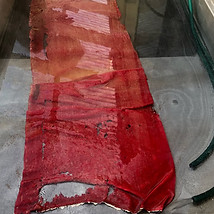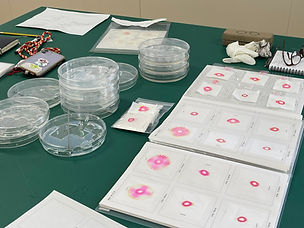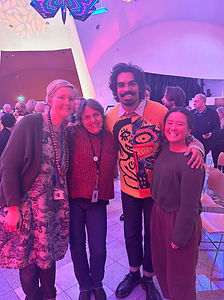
Images above are courtesy of Nobuko Katjitani's Reference Collection
Our Work
This is our Projects Page, showcasing some of our completed works and past projects. This page is still under construction. We will continue to add experiences. Please don't hesitate to contact us if you have any queries.



01
Tanner Shoes
Treatment of a pair of silk slippers belonging to one of the first settler families to WA. The treatment involved humidification, support and stitching a fine piece of dyed silk crepeline where the edging ribbon had disintegrated. A very tiny Japanese needle was used in the original stitch holes to avoid creating any new holes. The new binding held the ribbon fragments in place and the layers together.
02
Elastic/ Elastane Degradation Thesis Research


Based on challenges of conserving Akira Isogawa's elastic filled costumes from his collaborations with the Sydney Dance Company, held in the Arts Centre Melbourn collection, my Masters research thesis was on the degradation of elastic and elastane materials. Elastic and Elastane are usually made from polyurethanes; some of the most volatile plastics. I aged 12 different types of elastic in four different environments including high UV, high RH, low RH and low oxygen to compare which factors most affected degradation processes and which environment would slow degradation in order to inform storage recommendations. The WA Museum generously let me use their analytical lab to test my samples, including FTIR, XRF, Microscopy and colour spectrometry. Results showed that low RH was best environment for almost all elastic types. Low oxygen environments had a surprisingly negative effect, sometimes as drastic as UV exposure or high RH exposure in different types of elastic.

03
Tanner Dress Collection Documentation and Research
It was a privilege to be able to document and undertake both historic and scientific research this beautiful1780's- 1840's silk brocade dress belonging to one of the earliest settler families in Western Australia.
04
Editing the English Edition of
Dr Ishii's Books
I am so grateful to have been able to edit the English edition of Dr Ishi's comprehensive and detailed books on the The Conservation of Textiles in Museums. It is so wonderful to see so much generous knowledge and her lifetime of scholarship and work recorded and shared in a paper (and digital) form. The editing process helped to consolidate my learning, enabling me to go back over all the skills and processes she had taught me in my year of studies with her.


Courtesy of Dr Mie Ishii and Saga University

05
Japanese Prayer Flag
Documentation, analysis, treatment and rehousing of a WW2 Japanese prayer flag. The documentation and testing phase included UV, IR, Transmitted and visible light photography and FTIR helped to determine the content of the adhesive and ink stains. Tracing blood stains and holes onto mylar enabled the refolding (mylar) flag into its original form of being tied as a head scarve, and revealed the fragility of all the places throughout that would disintegrate with water due to contact with the iron stain damage. Treatment included testing gels and Delaware solutions, using acetone on the suction table and dyeing a silk crepeline lining adhered with Lascaux for an almost invisible support. Rolled storage was designed for the small storage space available and for ease of transport with the hope of being repatriated home through the Obon Society.







06
Kylie Minogue Costumes,
Arts Centre Melbourne Internship
My Masters internship was undertaken at the Arts Centre Melbourne. It included the documentation, treatments, and preparation for transport of two Kylie Minogue Showgirl costumes for a loan to the National Museum of Australia (NMA). I enjoyed creating detailed condition reports and packing and unpacking instructions for the transport and storage solutions we devised. Costumes have a unique mix of often new, experimental, and synthetic materials that bring with them special challenges for preservation.

07
Audrey Woods Emu Jacket
John Curtin Gallery
A small, sensitive repair was undertaken to prepare this jacket for display. The hand painted surface was respected as artist marks and stitching through the surface of the paint was avoided. Silk crepeline was dyed in many matching shades for the variety of pinks in the garment. Light adhesive based support was used to prevent the tear growing with the weight of gravity during display. Small support stitches were sensitively added where needed.
08
Pinjarra Jacket,
WA Museum
Treatment of this historically significant 1860's Pinjarra Mounted Volunteer's Jacket to support the disintegrating woollen lining so that is able to be displayed on a mannequin. Treatment involved supporting the fragile cream fabric where the weft was beginning to break throughout. Adhesives were avoided and the treatment involved wet cleaning and support stitching.



09
Costarella Corsage
WA Museum
A small adhesive repair to a feather corsage of a Costerella Coat. Defining and documenting the structure of the corsage was a unique challenge.
10
New Norcia:
Moving the Collection to New Storage Rooms
With the help of our wonderful team of volunteers from the WA Embroiderers Guild Collection Group, we managed to photograph, move, and safely store the entire ecclesiastical garment collection in the new storage racks and bags that we created. Such fun working with such a skilled, motivated, knowledgeable and organized team!







Linen fibres samples Courtesy of Nobuko Katjitani
11
Nobuko Katjitani's Reference Collection
During my year studying Textile Conservation at Saga University in Saga, Japan I had the privelidge of working on Nobuko Katjitani's reference collection. Nobuko headed up Textile Conservation at the MET for 40 years. Her lifetime of travel and collecting samples of textile materials and processes from throughout the world provides a rich resource to learn from. It was so special to be able to help to devise housing solutions for the materials and in recording the stories and intangible aspects of her collection in fascinating interview sessions.
12
John Hetherington Collection and
Mr Squiggle and Friends Exhibition Preparation
During my year working at the National Museum of Australia I helped to process and rehouse the Norman Hetherington collection (including 170 puppets), helped with the interviews, photography and filming sessions with Hetherington family discussing the intangible and changeable aspects of the collection, designed conservation repair solutions for puppets, collated the media launch exhibition and treated the enormous Reluctant Dragon backdrop.








13
Hetherington Reluctant Dragon Theatre Backdrop
This challenging but successful treatment of the enormous 12m x 9m Reluctant Dragon Backdrop involved consolidation of the water-soluble poster paint with funori, and the stitched support of the degrading hessian substrate onto painted infills. The project provided the opportunity to teach the conservation team at the NMA some support stitching techniques.
14
Community Access Visits NMA
My favourite part of working at the National Museum of Australia (NMA) and also working with other community groups has been helping with Community Access Visits. It was so precious to see how much more objects come alive when connected to the Communities to whom they belong. It is such a privilege to be invited to share that space, people's connection to their objects and to hear their stories.

Image is of Rinske Carr and the Embroiderers Guild accessing the New Norcia Spanish Textile Collection for study and research.



15
Textile Workshops for Adults and Children
Over the years I have thoroughly enjoyed running a variety of practical workshops ranging from Natural Dyeing Processes with children, and in Fibre ID and Analysis and in Construction of Support Mounts for Textile Conservation with interns and other conservators. I also run floristry workshops for the community that I currently work with.
16
ICCROM Arita 2019
Summer School
Communication Skills in Teaching Conservation and Science Course
-Student Assistant


During my year of study in Japan I was fortunate to be able to be one of the student helpers for the ICROM Arita course in Education and Communication in Conservation, that was running in a nearby Arita. I was able to join in all the activities with the inspiring group of Conservators from all over the world. So many valuable concepts, conversations, and perspectives! I also learnt an enormous amount about porcelain and its history in Japan.


Images courtesy of ICCROM and Saga University



17
St Werburgh's Red Linen Architectural Wall Linings
I helped Rinske with the treatment of the beautiful red linen that had been used as wall lining of the windows and alcoves in the St Werburgh's gothic style chapel, one of WA's earliest churches. The wall linings needed to be removed for conservation and repair of the walls to go ahead. It was quite a large volume of fabric to treat. They were reinstalled after the other works were complete. The rabbit glue came away easily with water but took many washes in warm water to dissolve from the textile.
18
Textile Conservation Studies
Saga University, Saga, Japan
March 2019 – March 2020
Studying under Dr Mie Ishii, we set our own course covering the full practical classes, and some of the theory, for the two years Masters of Textile Conservation in Glasgow. During this intensive year we covered natural and synthetic dye processes, fibre identification and solubility, wet cleaning, stitching, bleaching, adhesives, solvents, support methods, storage, and display methods, accelerated aging, analysis, and research. Some of the highlights of the year were working on Nobuko Kajitani’s reference collection, including interviews with her (full of fascinating stories), assisting at the ICOM Arita Summer School in Education and Training in conservation, attending the Kyoto ICOM Triennial, visiting the Kyoto Costume Institute, and meeting the Japanese textile conservators.













19
Rose Grainger's Dressing Table Contents Rehousing Project
A Masters' treatment group project where we collaboratively designed new housing for the contents of Rose Grainger's Dressing Table. We considered the needs and hazards of a wide variety of materials from metals, human hair, early semi- synthetic plastics to medicines. We designed layers of trays to separate off-gassing rubber and degrading early plastics from metals and silks and used charcoal cloth to absorb any chemicals that might be being released.
I always enjoy creating beautiful and functional housing, and clear, visually pleasing packing and unpacking manuals and instructions.
20
New Norcia Metal Fibre Treatments
I was incredibly fortunate that textile conservator Rinske Car so generously took me on, involved me in so many of her projects and taught me so much of what I know of textile conservation. I would not be where I am today without her support, encouragement and teaching. One of her and Ian McLeod's most innovative treatments is their removal of tarnish from metal fibres in a pH neutral solution. I had the chance to help with this process on several of the precious New Norcia textiles.



21
Gels Workshop- Saga University
June 2025
In June 2025, working with Mie and Masumi, I helped to run a workshop on the use of Gels in Textile Conservation. The workshop covered different types of gel materials, properties and concentrations, using them to measure pH and apply solvents. It was a practical hands-on workshop where we were able to thoroughly test all the gels, on a variety of different materials and see the effect they had on the same water-soluble ink. I spent the week following the workshop testing the use of the same range of gels and materials using the suction table.



Courtesy of Dr Mie Ishii and Saga University
22
Springfield Dress Mounting
At the NMA I thoroughly enjoyed working on the mounting supports for the 1890's Springfields dresses for display in the new Landmarks permanent exhibition. The Kyoto Costume Institute mannequins are a pleasure to work with and I enjoyed putting into practice all the skills and tips that the NGV textiles team generously shared with us in their mounting workshop at the 2024 AICCM Textiles Symposium.




23
Sharing Stories
Australian National University Program
Throughout 2024 I was fortunate to be able to take part in the ANU Sharing Stories Program. This rich learning experience was undertaken over the course of the year. We went on many walks and camps with Traditional Owners and Knowledge Holders who shared their stories with us. The areas included the Canberra Kambri region of the Ngunnawal, Ngunawal and Ngambri peoples and Yuin Country down on the South Cost of NSW. At the end of the year, we responded with an artwork. I also found the rich, reflective discussions with other artists, environmentalists, and cultural workers participating in the program so valuable.
'Silences are not just absences,
Silences are discernible and palpable,
They shape conversation and writing,
They are enacted and constructed,
We need to pay silences as much attention as official whitenoise.'
Bernard Smith 1980 (The Boyer Lectures)
24
Tony Armstrong Extra Ordinary Things
Shearing Ribbons Mounting and Installation
Displaying the enormous number of shearing ribbons from Tony Armstrong's Extra Ordinary Things TV show, in a space only just long enough to fit them was a challenge. We used a fabric covered board and I carefully supported them with stitching mostly only along seams and the braid edging. I couldn't stitch into the satin as it would leave permanent holes and it was not quite long enough to hang the bottom ribbons below, so I had to stitch and pin a few folds into the last ribbons (woolen felt).





25
Adachi Collection
City of Belmont Museum
I recently treated a collection of Japanese dolls, accessories and kimonos for the Belmont Museum. Funori (a seaweed adhesive) was traditionally used for setting wigs and 'starching' kimonos as it can be washed out, unlike starch. It worked so well at containing loose strands of silk in the dolls hair.